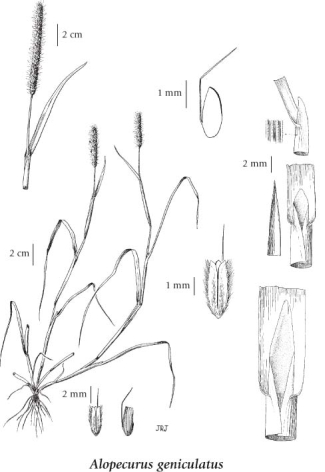Click on the image below to view an
expanded illustration for this species.

|
General:
Perennial, tufted grass from fibrous roots; stems erect to decumbent, rooting at the nodes, (20) 30-50 cm long/tall.
Leaves:
Sheaths open; blades flat, rough on the upper surfaces, less rough short-hairy to nearly smooth beneath, 2-6 mm wide; ligules slightly toothed or jagged across the narrow tips, the tips more or less pointed but usually blunt, (2) 3-5 mm long.
Flowers:
Inflorescence a pale green to purplish-tinged, cylindrical panicle, mostly 2-7 cm long; spikelets 3.2 mm long or less (excluding the awns); glumes 2 (2.5-3.5) mm long, more or less silky hairy over the back on the keels and nerves, fringed with long, fine hairs on the keels, tips rounded and translucent; lemmas with margins fused to below their midlength, subequal to the glumes, nearly blunt, awned, the awns inserted barely 0.5 mm above the base, abruptly bent and twisted, rather stout, about equal to or slightly longer than the glumes, 4-5 (6) mm long; anthers 1.2-2.2 mm long.
Notes:
Although thought to be introduced, A. geniculatus occurs in natural habitats, especially in the Queen Charlotte Islands. Includes plants misidentified as A. saccatus Vasey, which is a distinct, annual species of CA and OR.
Source: The Illustrated Flora of British Columbia
|
